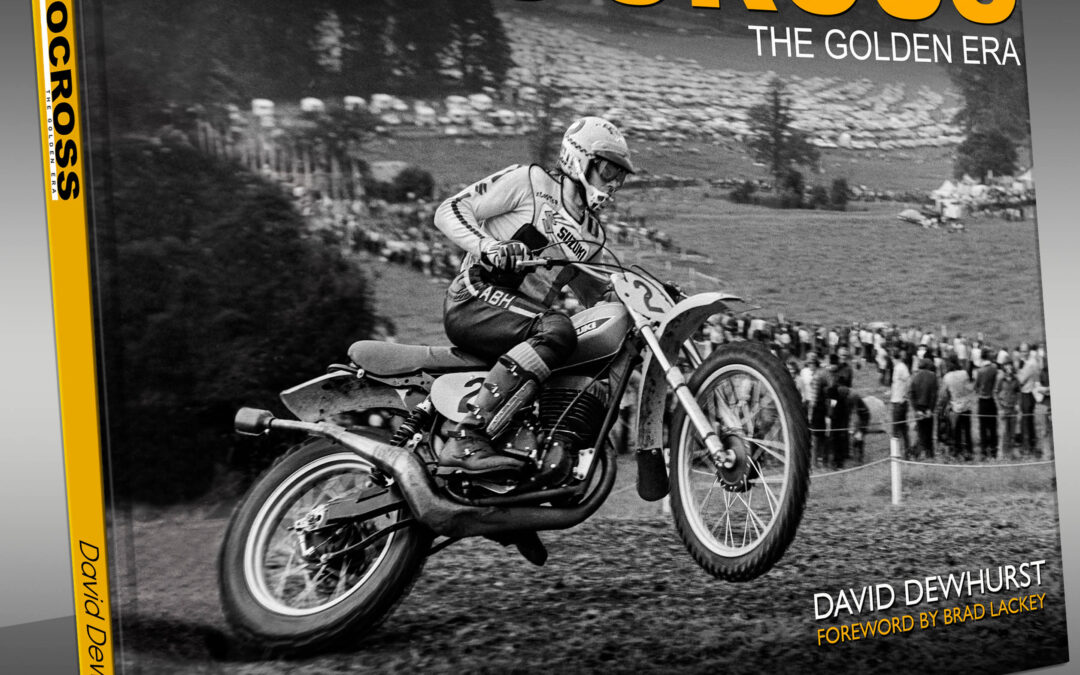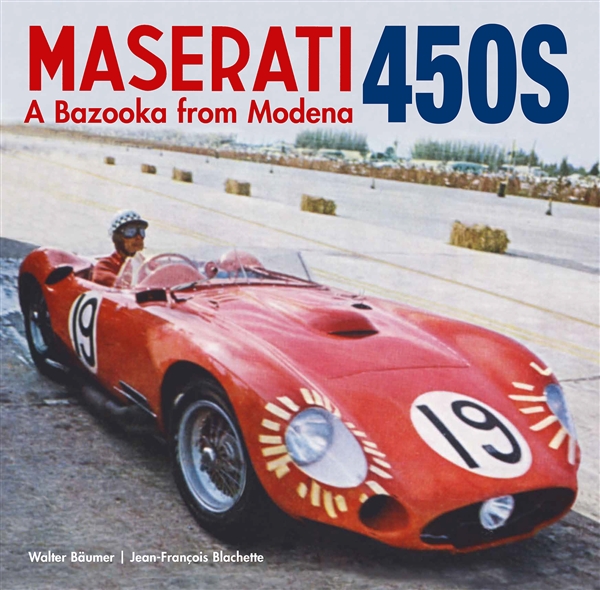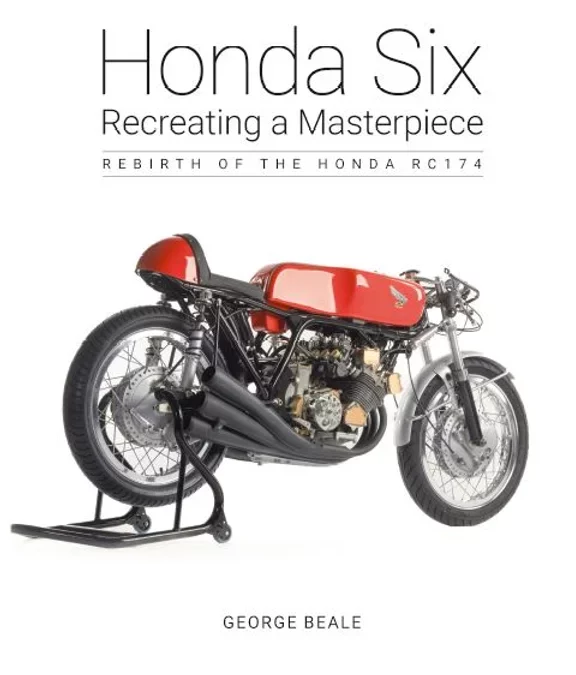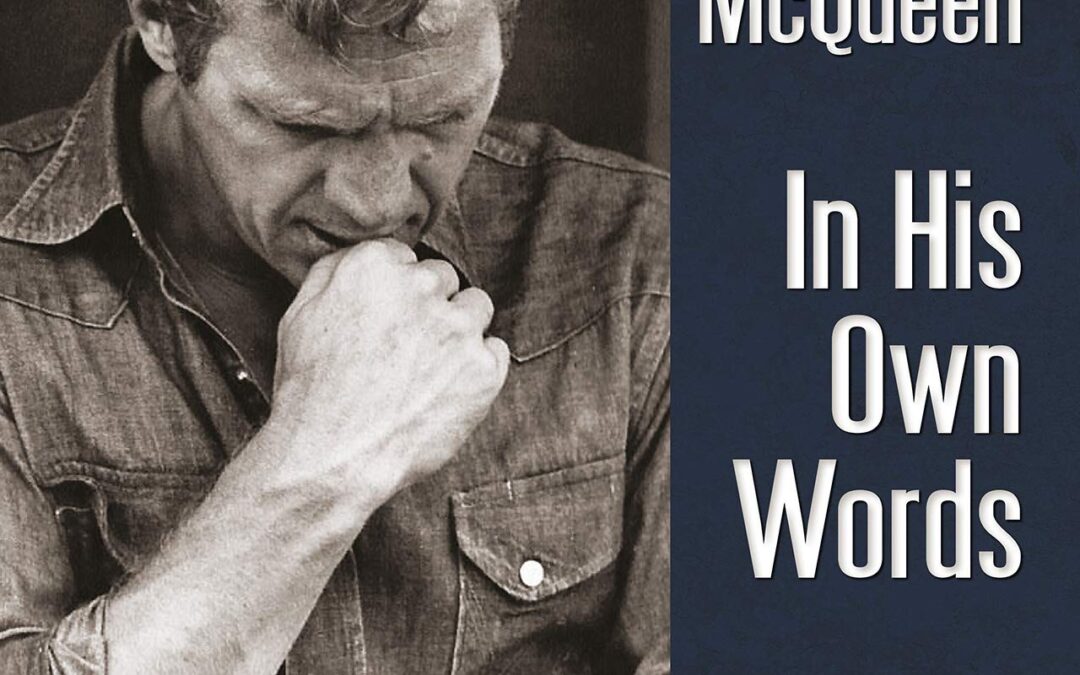
The Places They Raced: Circuits of the Golden Age
WE’RE big fans of the style of this book, which simply has great pictures of pre-1918 circuit racing – be they photographs, slides or postcards – as well as brief captions. It’s an interesting look into the ‘golden age’ of racing.
European city to city races, Gordon Bennett Trophy
Consisting only of pre-WWI postcards of Renaults, Brasiers, Napiers and the like slithering over rutted muddy road circuits, this little hardback conveys the raw nature of early racing in spades. Many shots show the roads on non-race days, cluttered with chickens, bicycles and dog-carts, making it tempting for cartophiles to do some Google Earthing.
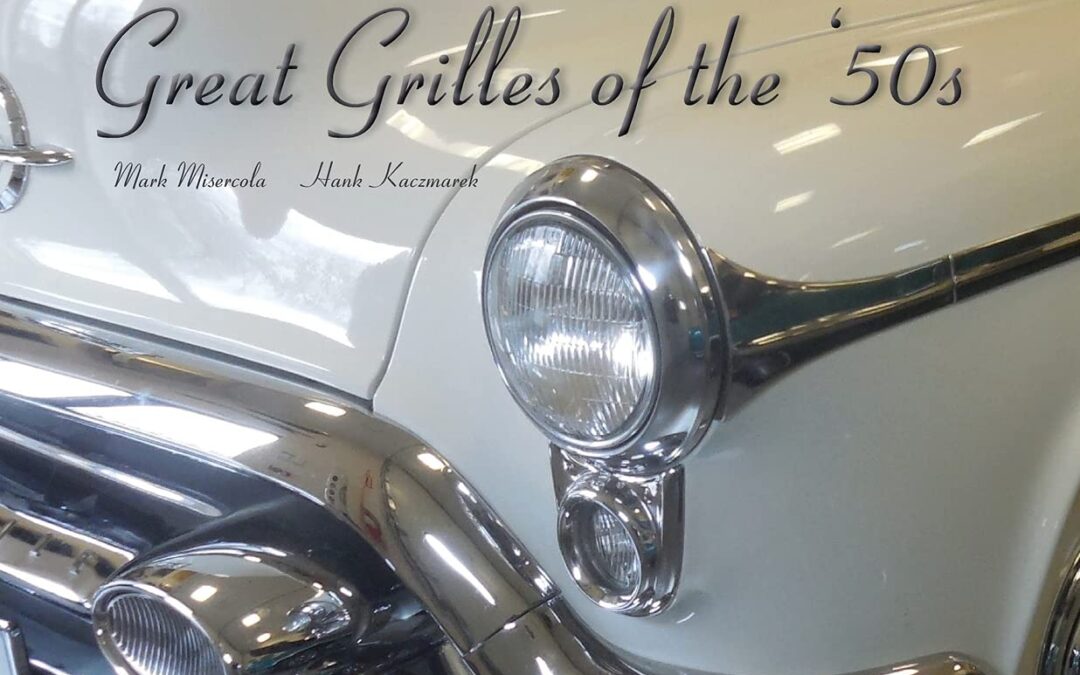
The 1950s was a golden era for Detroit, reflecting the endless optimism and futuristic view in America following World War II. Car designers and stylists were inspired by current day fighter jets, space age technology, and chrome. Their creations sported great chrome grilles, bullet-nosed bumpers, enormous tail fins, cockpit-styled dashboards, and frames as big as aircraft carriers. The allure and emotional appeal of these cars has been well document in countless books over the years. But without exception all of these titles look fabulous 50s vehicles as the sum of their parts. None focus specifically on what many consider to be the most distinguishing aspect of many of the cars from the fabulous 50s their front grilles. Great Grilles of the 50s provides a close-up view, both visually and in narrative form, of the best and most dynamic grilles of the era. This 11 x 8.5 inch coffee table size book features 104 all color pages on acid free paper with library quality binding.
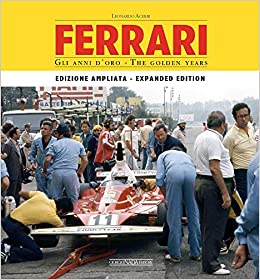
Ferrari’s sporting history, from the origins to 1988, the year of Enzo Ferrari’s death, narrated in 400 pages and more than 700 photos, most of which previously unpublished and drawn from the publisher’s own archive. More than a book, Ferrari The Golden Years this is a unique and prestigious document that reviews year by year, from 1947 to 1988, the true sporting epic of Ferrari’s Ferrari. Page by page, we find champions of the calibre of Tazio Nuvolari, Alberto Ascari, John Surtees, Niki Lauda, Gilles Villeneuve and many others, who in Formula 1 and elsewhere won world titles at the wheel of unforgettable cars such as the 500 F2, the 158 F1, the Testa Rossa, the 250 GTO, the 330 P4 and the successful 312 T family, from the 1950s through to the late 1980s. This new enlarged edition includes not only champion drivers, but also the men and the mechanics who lived in close contact with the Drake. They are described in specific text boxes: from Romolo Tavoni to Mauro Forghieri, from Franco Gozzi to Marco Piccinini, from Ermanno Cuoghi to Giulio Borsari. All accompanied by contextual texts by Leonardo Acerbi, a Ferrari historian of great experience. The book contains a unique collection of images, many in black and white but also a series of very rare colour shots, the majority by Franco Villani, a great reporter long associated with the Prancing Horse. An album allowing us to relive one of the greatest sporting stories of all time.
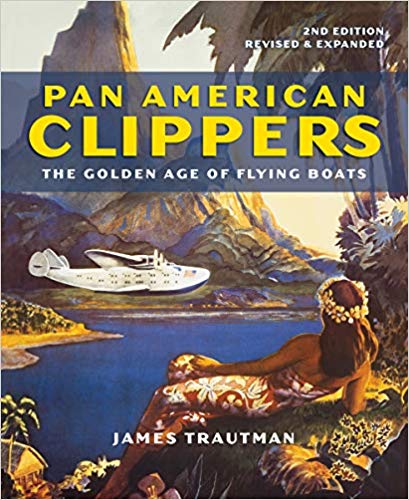
The photographs and artwork will enable readers to grasp the magnificence of the transoceanic flying boats…The accurate, authoritative text will provide information that is new to all but the exceptionally well-informed aviation buff and nonspecialist historian.”
–Choice
For a world recovering from the Great Depression, the Pan American Airways Clipper symbolized luxury, adventure and a brighter future. Illustrated with rare period photographs, vintage travel posters, magazine ads and colorful company brochures, Pan American Clippers covers all aspects of the Golden Age of Pan American’s graceful “flying boats.”
This edition has an additional 16 pages to add more historical and current information and provide additional detail and context to the historical importance of the flying boats, including:
- Pan Am’s Art Deco terminals
- the fate of the last Pan Am Clippers and where to see the survivors
- the Foynes Flying Boat Terminal, Ireland
- Trippe and Lindbergh’s groundbreaking flight to Asia by way of the Great Circle Route (Canada-Alaska-Siberia-Japan-China)
- Shediac, New Brunswick, landing site of 24 Savoia Manchetti S-55 flying boats from Rome en route to Chicago’s Century of Progress International Exposition
- Pan Am enters politics when Frank Roosevelt uses it in Latin America to sidestep the World War II Neutrality Act
- Trippe’s long-held dream of flying mail and passengers across the Atlantic Ocean to Europe, and the opening of LaGuardia Airport.
Visionary Pan Am founder Juan Trippe knew the importance of international travel to the 20th century, and his pioneering airline played a central role in the advancement of transoceanic flight, setting overseas time and distance records, providing airmail delivery and eventually as troop and cargo transports for the Allies during World War II. By dramatically reducing travel time and opening up international air travel to the general public, Pan Am Clippers forever changed the world.
This captivating, informative and richly illustrated book takes readers back to a time of glamor, romance and progress, when dreams once thought impossible were suddenly a reality.
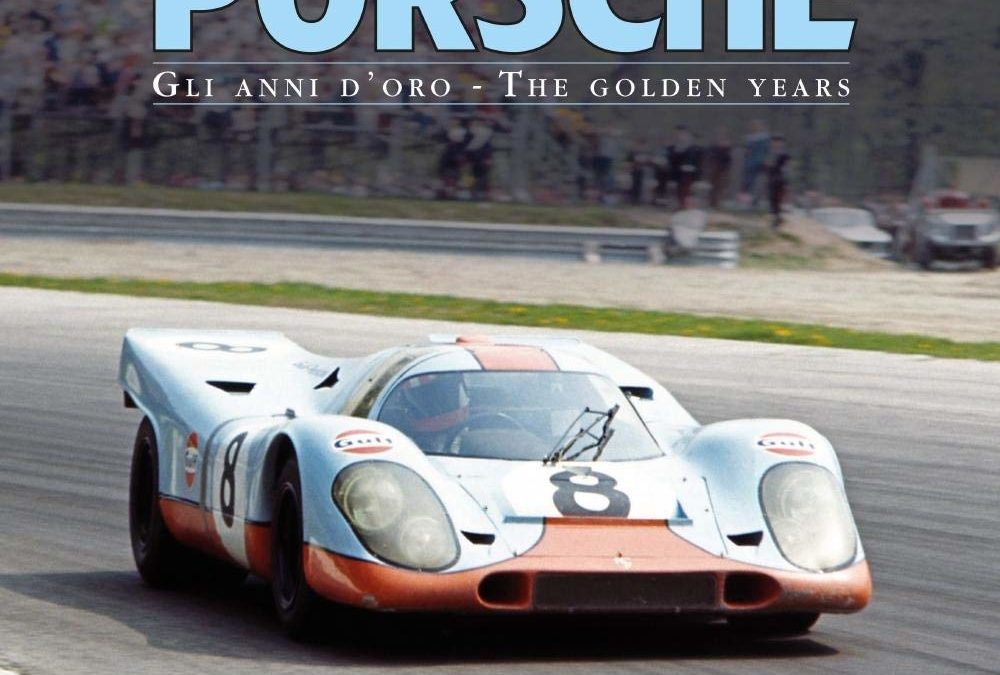
Iconic cars such as the 356s and the immortal 911s, extraordinary success stories in the classic endurance races, great champions and remarkable engineers. These are the principal ingredients of Porsche: The Golden Years, a book examining the full history of the legendary Stuttgart firm, with spectacular and previously unpublished images by photographer Franco Villani. The Porsche 356, with both closed and open bodywork, was the model that in 1948 officially inaugurated the catalogue of the celebrated Stuttgart firm. In that difficult period of reconstruction, Dr. Ferdinand Porsche, artificer of the car and founder of the marque, was already an undisputed authority in the automotive field for having designed the Volkswagen Beetle, the people’s car. The Porsche 356s were “legitimate offspring” of the Beetle and soon found favour with the public: they were sporting cars that were easy to use in everyday life. This is the true Porsche “DNA”, confirmed with the launch of the 901, or rather the 911 that first saw the light of day in 1963, a model that soon became a planetary success story, a car capable of traversing the decades while maintaining intact its appeal. The Porsche name also evokes the innumerable victories obtained in legendary endurance races such as the Le Mans 24 Hours and the Targa Florio, in the World Rally Championship and in the great African raids such as the Paris-Dakar, as well as in Formula 1 as an engine supplier to McLaren in the early ‘80s.

In the best-selling original book, Hot Rod Gallery: A Nostalgic Look at Hot Rodding’s Golden Years: 1930-1960, author and historian Pat Ganahl opened his archives and shared 192 pages and 350 photos of “some” of the most interesting and best photos of his collection. Filled with fascinating images of some of the coolest cars and builders, long-forgotten car clubs, and great shots of the dry lakes, nostalgia fans flocked to grab a piece of hot rodding history all in one convenient package. Well, if some is good, more is better, right?”
In Hot Rod Gallery II: More Great Photos and Stories from Hot Rodding’s Golden Years, Ganahl dug deeper into his massive archive for even cooler and more never-before-seen photos in both color and black and white to provide another album of great hot rodding photos. He was pleasantly surprised to find that he had more great stuff in old files and folders, hidden away for decades. In this edition are even more dry lakes shots, post-war rods, lead sleds, show circuit cars, and a chapter on marvelous mills. He even dug a little deeper into the early 1960s.
If you liked the first edition of Hot Rod Gallery by Pat Ganahl: A Nostalgic Look at Hot Rodding’s Golden Years: 1930-1960, you may like this one even more. Ganahl guarantees that it is filled with images you have never seen, and he offers his commentary and a lifetime of expertise in this selection of fantastic images from his expansive archive. You can spend hours looking at all the details and soaking in the history in these images, and we know you’ll enjoy this book as much as you did the first.
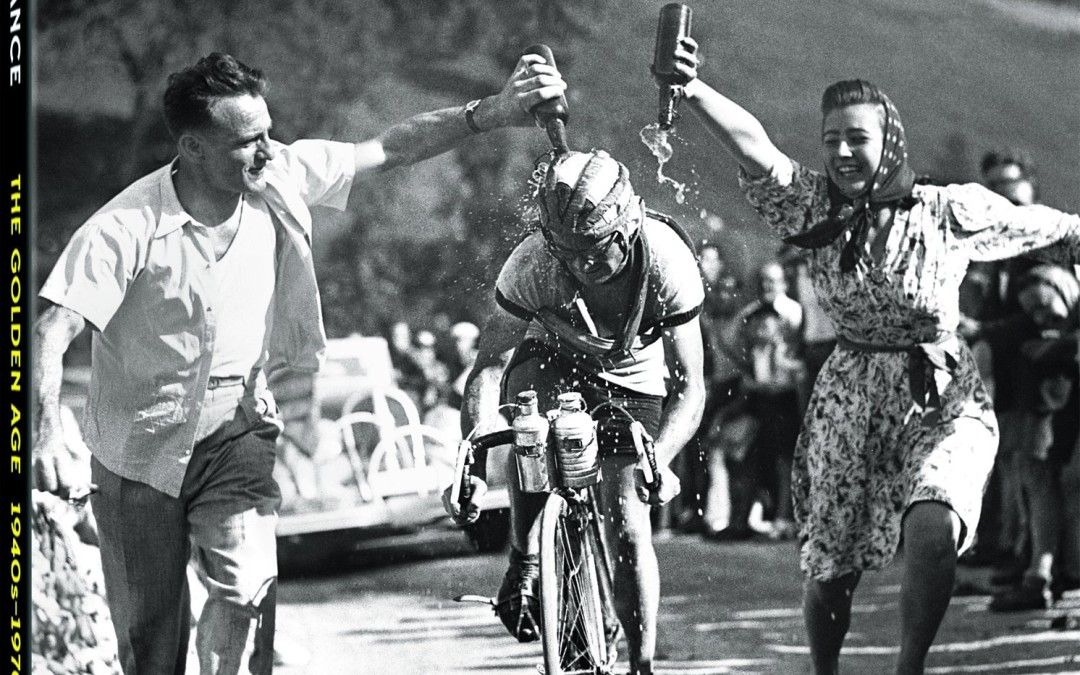
“Eagle of Toledo” and “The Cannibal,” “The Angel of the Mountains” and “Leatherhead.” A sporting event where the heroes earn nicknames like these must be incredibly powerful and alluring. The names reflect the nearly mythical aura surrounding the Tour de France. The men who bore these monikers, Federico Bahamontes and Eddy Merckx, Charly Gaul and Jean Robic, are only some of the protagonists representing the golden era of cycling who appear in this wonderful coffee table book. We see them on their legendary mountain stages, marked by inhuman strain and exertion, and as victors at the finish line, relieved and feted by cheering crowds. As appealing as these pictures from the 1940’s to the 1970’s are, some of their charm comes from the odd detail that makes a contemporary viewer smile: the leather helmet Jean Robic wore (ergo “Leatherhead”), or cyclists repairing and inflating tires themselves. Especially impressive are the photo series of epic duels, such as the one between Jacques Anquetil and Raymond Poulidor. Whether color or black and white, the photographs in this volume have a very special patina that allows the reader to revel in the greatest moments of a race that has enthralled millions of people since 1903.

“THE GOLDEN AGE OF AVIATION SERIES takes a look at the respective airplane manufacturer from start-up (and before) through the struggling years of the Great Depression through the end of World War II and beyond to the postwar boom/bust. This series is a compilation featuring the combined research and writings of Drina Welch Abel, Alan Abel, and the late Paul Matt. The 3-view scale drawings used in our Golden Age books have been reviewed, acclaimed and praised by the aviation press in every continent of the world! CESSNA’s GOLDEN AGE takes a look at Clyde Cessna and nephew Dwane Wallace, longtime Cessna President, and the Cessna Aircraft Company from the early 1900s, through the struggling years of the Great Depression, through World War II to the post-war years.
It includes Cessna’s biographical information and details the people, facilities and manufacturing operations of Cessna during the Golden Years. Emphasis is given to Cessna Primary Gliders, Cessna Airmasters, Cessna T-50 Bobcats, Waco CG-4A Gliders (Cessna built), and Cessna 120/140 airplanes. Other Cessna models are also included. There are several factory photos of the Cessna plant during the Golden Years, among the book’s 180 photos and many illustrations, including 3-view airplane scale drawings.
”
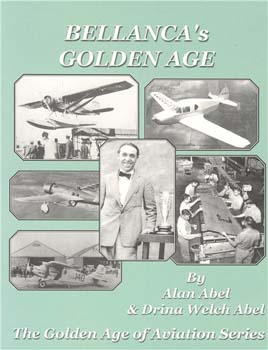
BELLANCA’s GOLDEN AGE is a new book included in The Golden Age of Aviation Series. Book Reviews for The Golden Age of Aviation Series: Smithsonian’s Air & Space: “Archival photos and technical drawings abound.” American Aviation Historical Society: “…details the people, facilities and manufacturing operations.” EAA’s Sport Aviation: “…progressively tells the events and details of these aircraft.” Skyways: “Your new series is a hit of the first order!” SR Batteries: “…just wonderful reading!” General Aviation News: “…books ARE A MUST FOR AVIATION BUFFS.” THE GOLDEN AGE OF AVIATION SERIES is being published to commemorate this year’s 100th Anniversary of Flight (2003), and presents an historical look at Aviation’s Golden Years through detailed and meaty text, numerous original photos, many of which have never been published before now, original magazine advertisements of the era, and internationally acclaimed 3-view Scale Drawings. This new series of books highlights a number of airplane manufacturers during the 1900s through 1950. THE GOLDEN AGE OF AVIATION SERIES takes a look at the respective airplane manufacturer from start-up (and before) through the struggling years of the Great Depression through the end of World War II and beyond to the postwar boom/bust. This series is a compilation featuring the combined research and writings of Drina Welch Abel, Alan Abel, and the late Paul Matt. The 3-view scale drawings used in our Golden Age books have been reviewed, acclaimed and praised by the aviation press in every continent of the world! BELLANCA’s GOLDEN AGE Traces G.M. Bellanca coming from Sicily to America as a teenager in 1911 through his 42 years of continuous airplane manufacturing operations. He did more for aviation than any other single individual during aviation’s first 100 years, bar none! This is the ONLY BOOK that has ever captured Bellanca’s complete and lengthy story. Details the beginnings of the air transportation system over great distances. Details the first ten flights over the Atlantic and the first flight over the Pacific. Tells never-before-told stories of Charles Lindbergh, Clarence Chamberlin and many other Golden Age personalities. Tells the complete story of the greatest airplane of the 1920s — Bellanca’s Columbia (the plane Lindbergh wanted but didn’t get). In the 1930s the government tested 209 different airplanes and found that Bellanca’s was the best regarding “efficiency.” Details Bellanca airplanes: CD, CE, CF, Wright-Bellanca 1, WB-2, Columbia, Bellanca J, TES Tandem, Pacemaker, Special J-300, Model K, Airbus/Aircruiser, C-27A, Miss Veedol, The White Falcon, Senior Skyrocket, The Flash, XSE-1, XSE-2, Bellanca Racer, Cruisair Junior, YO-50 (liaison), AT-21-BL Trainer, Cruisair Senior, Cruisemaster.

AERONCA’s GOLDEN AGE is a new book included in The Golden Age of Aviation Series. Book Reviews for The Golden Age of Aviation Series: Smithsonian’s Air & Space: “Archival photos and technical drawings abound.” American Aviation Historical Society: “…details the people, facilities and manufacturing operations.” EAA’s Sport Aviation: “…progressively tells the events and details of these aircraft.” Skyways: “Your new series is a hit of the first order!” SR Batteries: “…just wonderful reading!” General Aviation News: “…books ARE A MUST FOR AVIATION BUFFS.” THE GOLDEN AGE OF AVIATION SERIES is being published to commemorate this year’s 100th Anniversary of Flight (2003), and presents an historical look at Aviation’s Golden Years through detailed and meaty text, numerous original photos, many of which have never been published before now, original magazine advertisements of the era, and internationally acclaimed 3-view Scale Drawings. This new series of books highlights a number of airplane manufacturers during the 1900s through 1950. THE GOLDEN AGE OF AVIATION SERIES takes a look at the respective airplane manufacturer from start-up (and before) through the struggling years of the Great Depression through the end of World War II and beyond to the postwar boom/bust. This series is a compilation featuring the combined research and writings of Drina Welch Abel, Alan Abel, and the late Paul Matt. The 3-view scale drawings used in our Golden Age books have been reviewed, acclaimed and praised by the aviation press in every continent of the world! AERONCA’s GOLDEN AGE progressively details the events leading to the Aeronautical Corporation of America, from the early 1920s, through the Great Depression, the disastrous flood of 1937, World War II and beyond. Book includes biographical information on the founders of Aeronca, and details the people, facilities and manufacturing operations of Aeronca during the Golden Years. Emphasis is given to Aeronca’s C-2, C-3, Model K, Model L, 7AC Champ, and 11AC Chief. ALL Aeronca’s models are discussed. Includes factory photos. This book has much more information than the previously published book, Aeronca, The Best of Paul Matt.

Rediscover the Golden years of Formula 1 through the perspective of F1 helmets!
18 F1 drivers, including 5 world champions took part on this project. We also interviewed the finest painters and technicians of the major helmets brands.
Formula Helmet is a wonderful book detailing the evolution of helmets in Formula One racing from 1969 to 1999, often referred to as the ‘Golden Era’ of F1 and helmet design. The book was compiled and written by Bruno Bayol, with a foreword from the incomparable Scotsman Jackie Stewart. And it’s subtitle “The Glory Years Of F1 Helmets” really does describe how iconic the drivers, car & helmet liveries were back then and how safety & design worked hand-in-hand.
The book is filled with incredible photography and content and is divided into 5 sections: Evolution, Hommage, Design, Marques and Champions. It will bring back many great memories for everyone from the casual F1 fan to the avid racing aficionados of this era of motor sport.
In order to celebrate one of the most epic duels of that era (1969-1999), we offer you the choice between Alain Prost and Ayrton Senna covers.
Each edition is printed at 1480 units only; all are numbered with a special sticker.

Rediscover the Golden years of Formula 1 through the perspective of F1 helmets!
18 F1 drivers, including 5 world champions took part on this project. We also interviewed the finest painters and technicians of the major helmets brands.
Formula Helmet is a wonderful book detailing the evolution of helmets in Formula One racing from 1969 to 1999, often referred to as the ‘Golden Era’ of F1 and helmet design. The book was compiled and written by Bruno Bayol, with a foreword from the incomparable Scotsman Jackie Stewart. And it’s subtitle “The Glory Years Of F1 Helmets” really does describe how iconic the drivers, car & helmet liveries were back then and how safety & design worked hand-in-hand.
The book is filled with incredible photography and content and is divided into 5 sections: Evolution, Hommage, Design, Marques and Champions. It will bring back many great memories for everyone from the casual F1 fan to the avid racing aficionados of this era of motor sport.
In order to celebrate one of the most epic duels of that era (1969-1999), we offer you the choice between Alain Prost and Ayrton Senna covers.
Each edition is printed at 1480 units only; all are numbered with a special sticker.
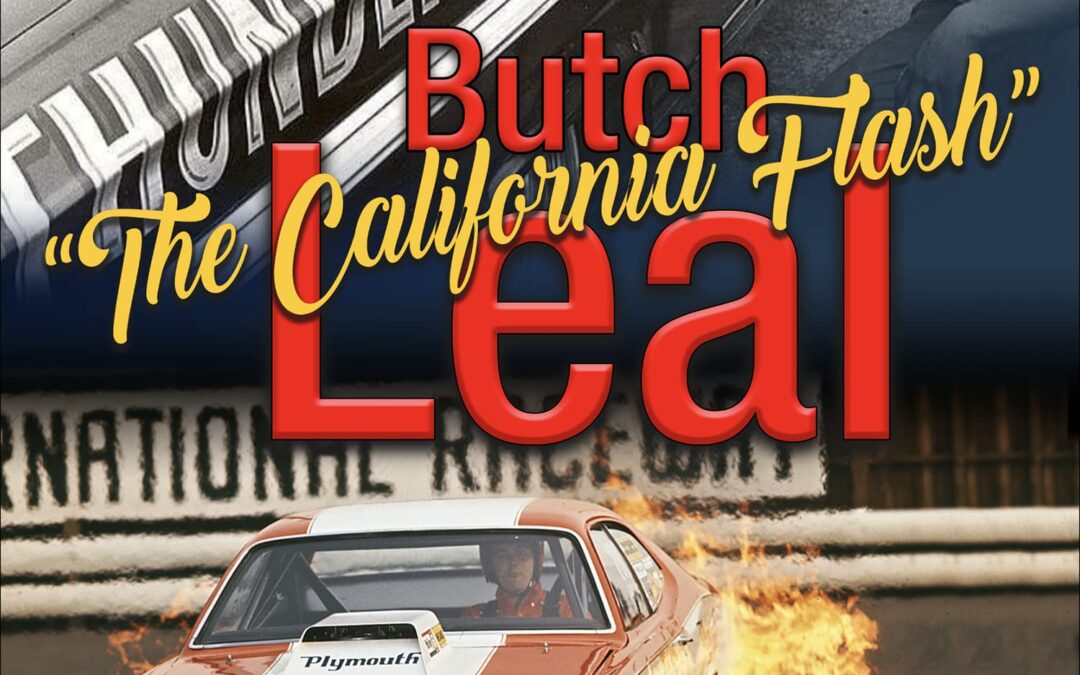
Check out the first ever biography on the popular drag racer, Butch “The California Flash” Leal.
Born and raised in central California, Larry “Butch” Leal was obsessed with cars from a very early age. What began with field cars turned into hard work and new Chevrolets. This took place when the golden era of drag racing was in its infancy, and Leal joined with enthusiasm. He performed well at the track with his early Chevys and had an impressive number of wins before he was out of high school. His success brought him plenty of attention and collaboration with other big names in the sport.
In 1963, GM pulled out of the sport on an official basis. As a result, Butch (at age 19) teamed up with Mickey Thompson and joined the Ford camp, securing a ride with the factory team and its new Thunderbolts for 1964. After his success that season, including winning the Super Stock (S/S) class at the 1964 NHRA US Nationals in Indianapolis, Chrysler came calling, and Butch signed on to race the new altered-wheelbase cars in match races for 1965, as the NHRA did not have a class for these new “funny” looking cars. While Leal dabbled again with Ford and Chevrolet later, his relationship with Chrysler lasted well into the following decades, running both Funny Cars and Super Stockers.
Penned by talented automotive historian Bob McClurg, who was there for it all, and featuring full collaboration with the book’s subject, Butch “The California Flash” Leal covers the span of his fascinating career during arguably the most interesting era in drag racing history. Butch was an 11-time NHRA champion and 4-time recipient of Car Craft magazine’s All-Star Driver of the Year award in a career that spanned the 1960s through the 1990s. It’s all here, the events, great vintage photography, and the stories from one of the best storytellers the NHRA has ever known. Add this entertaining volume to your drag racing library today.
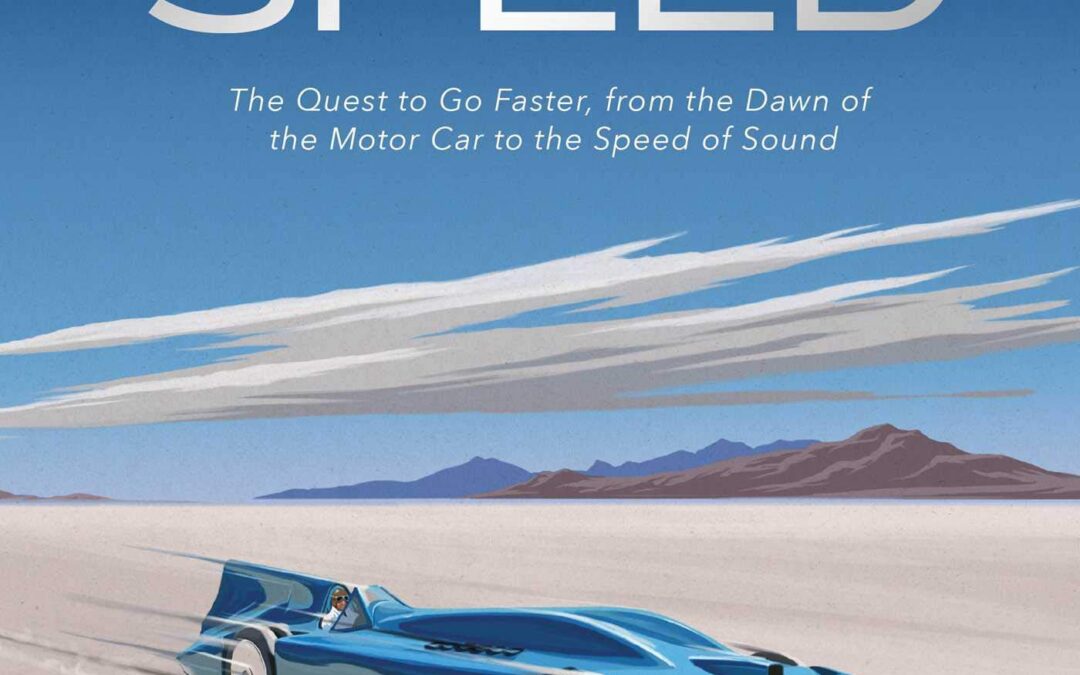
‘A special treat…The pictures and stories combine to provide a rich texture to telling the difficult story of why we chase speed like an addiction.’ Valerie Thompson, the world’s fastest female motorcycle racer
Ever since we built machines that could transport us, there has been a desire to find ways to make them go faster. For some, going faster isn’t enough – they want to be the fastest. This book celebrates those who have built the machines and driven them at ever greater speeds. This is The History of Speed.
Bestselling automotive writer Martin Roach tells the extraordinary story of those who have come to be obsessed by speed. From Camille Jenatzy, ‘the Red Devil’, who became the first man to drive at over 100kmh in 1899, through the golden age of Malcolm Campbell and his Bluebird, and on to the modern era of jet- and rocket-propelled cars, we have gone faster and faster. But this book is not just about these record-breakers, Roach also looks at the technology, the engines and the inventors who helped progress in speed at all levels, from Formula One to the supercars from the likes of Ferrari and Mercedes that are eagerly snapped up by collectors, rarely to be seen on the road.
Accompanied by some of the most stunning images of the cars and those who made and drove them, Roach tells a wonderful story of innovation and invention. He talks to some of the great drivers to find out what inspires them to risk their lives, and finds out from engineers how they developed their ideas. Along the way, we hear some remarkable tales and anecdotes, but also find out how the pursuit of speed can also have its costs, with many tragic heroes and heroines falling along the way.
If you’ve ever thrilled to the roar of a sports car engine, or loved the feel of the g-force as you accelerate away, or even looked on in wonder at a powerful engine, The History of Speed is a book that you will not want to miss out on.
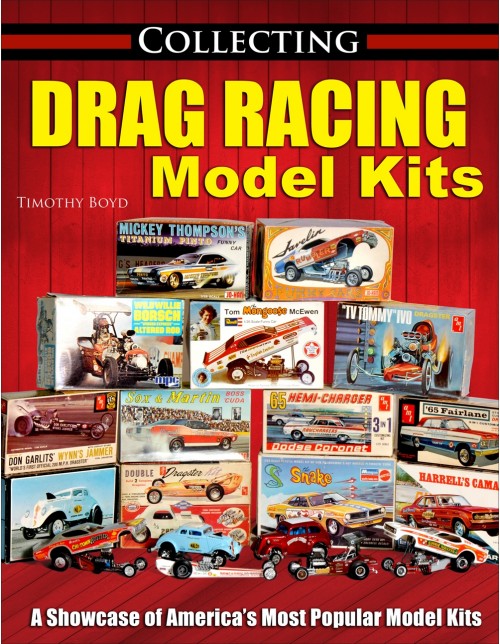
Relive the golden age of drag racing through this exhaustive volume covering the best drag racing model kits of the era.
Model expert Tim Boyd, author of Collecting Muscle Car Model Kits, turned his attention to the fantastic drag racing model kits available from the late 1950s through today. Some racing model kits were actually 3 in 1 kits, where the builder assembled the drag-race version of the car in lieu of the street or custom version. Boyd starts by covering the options, collectability, variety, availability, and value of these wonderful kits and then concentrates on the highly detailed drag racing-only kits that became available starting in the mid-1960s through today. He also shows the differences between original kits, older reproduction kits, and new reproduction kits that many enthusiasts find at swap meets and through online sources today.
Many of these great kits were from the 1960s, an era when building model kits was a widely popular, serious hobby, similar to video games today. Not only was it fun to build the kits but it was also a great way to learn about all the different race classes and categories because there wasn’t regular TV or online coverage during that era. The artwork on those kits was fantastic, and many collectors today seek original kits largely because of it.
The classes of racing covered are Gassers, Rail Dragsters, Stocks and Super Stocks, Funny Cars, Pro Stocks, Exhibition Racers, and more. Drag racing cars that never actually existed but were created by model companies are also covered.
Nostalgia drags are some of the most popular events around the country today. People can’t get enough of these old race cars that were built in an era when variety, innovation, and home building ruled the day. This book is great for modelers in general, model-kit collectors, and drag-racing fans young and old alike.
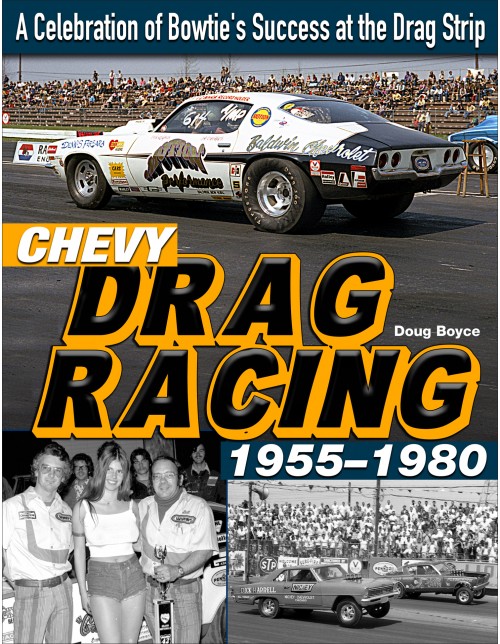
Relive the glorious first 25 years of Chevy drag racing in this comprehensive and nostalgic history.
With the introduction of Chevy’s OHV V-8 in 1955, the brand’s domination on the drag strip immediately snowballed. Drag racers loved the compact V-8. It was lightweight, revved high, and responded like no other engine previously produced. Chevy saw a record year in sales in 1955, thanks to a combination of a restyled body and the new mill. It was the age of ingenuity, and those who could get their hands on the new engine were swapping it into engine bays that once housed other weaker mills. Ford’s flathead, one that had dominated for so long, was rendered obsolete almost overnight.
Chevy had a winner and dominated the sales charts for years to come. Aftermarket manufacturers got on board and offered all the go-fast goodies needed to make Chevy a winner, no matter what category they ran. From Dragsters to Stock, Chevy’s success was immediate. And it was a long-term success, thanks to a combination of years of great styling and a vast array of driveline combinations.
Accomplished racing author Doug Boyce takes a celebratory look at those years of success, with a focus on the first 25 years (1955 through 1980). Chevrolets gave rise to such stars as Bill Grumpy Jenkins, Jungle Jim Liberman, Sneaky Pete Robinson, “Dyno Don” Nicholson, Sox & Martin, Dick Harrell, Dave Strickler, and many more. World champs and fan favorites all drove Chevys. The success showed in the record books. No brand has won more races and events or has set more national records than Chevrolet. And unlike the other manufacturers, Ford and Chrysler, it was done with little to no factory support.
Whether you are a hardcore Chevy fan or just love catching up on the history of drag racing during the golden age, this nostalgic look at Chevy racing history is sure to entertain for hours on end.


